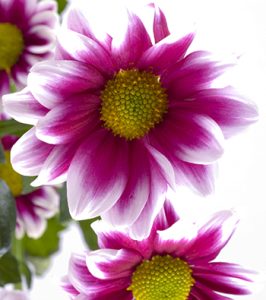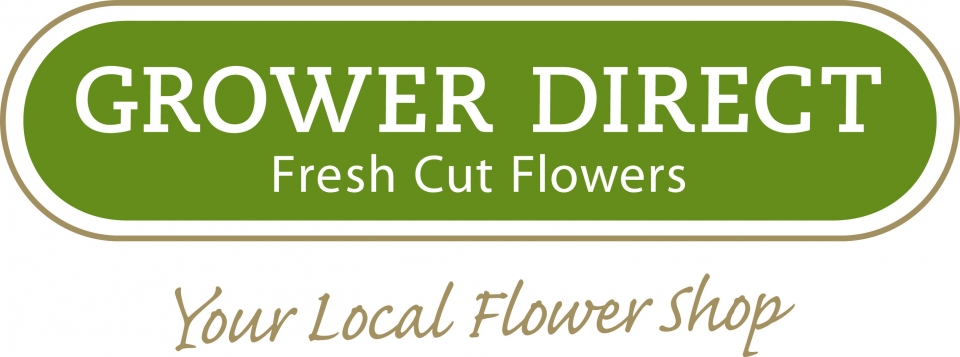![]() Prices in Canadian Dollars.
Prices in Canadian Dollars.![]() Prefer to call and speak to a floral agent? 1-877-277-4787
Prefer to call and speak to a floral agent? 1-877-277-4787
Hardware Flowers
In the North American floral industry, we use the phrase “Hardware flowers” to describe all the flowering species (except roses) which are sold commercially as cut flowers for display. For more information on the hardware flowers you are likely to find in a Grower Direct flower shop, see below.
Alstroemeria
Pronunciation: ahl-stroe-me-ree-uh
Species Name: Alstroemeria pelegrina
Named after Swedish botanist Baron Claude von Alstroemer. In 1753, von Alstroemer grew and identified this flower from some South American seeds he had collected in Spain. Alstromeria is also called Peruvian Lily or Inca Lily. Each stem holds many delicate, trumpet-like blooms that are up to 2″ in diameter. There are about 60 known species of Alstromeria which can be divided into two main varieties: the orchid type and the butterfly type. Blossoms come in many shades of pink, salmon, orange, red, yellow, purple, lavender and white, all speckled with black or dark brown flecks on the petals. With proper care and flower preservative, Alstroemeria has a vase life of 14 – 21 days.
Design Suggestions:
Use with elegant flowers or mix with Pompons, Mini Carnations or Carnations. Place in a clear vase with a large tapestry bow to show off colours and vibrancy. Use in an arrangement with Statice and Pompons to create a Victorian look. Display 2 – 3 stems in a straight-cut, glass vase for an elegant table center.
Carnations/Mini Carnations
Species Name: Carnation – Dianthus caryophyllus
Mini Carnation – Dianthus caryophyllus nana
The name ‘carnation’ comes from an old Italian word meaning “complexion”. The earliest Carnations bore flesh- coloured flowers, which gave rise to the name. Carnations were first discovered in the Far East. These flowers are widely mentioned throughout Roman mythology and even appear in the natural history records of the Roman writer Pliny, back in 50 B.C. It is believed that cultivation of the carnation began in the late 13th century, by Roman monks who saved seeds from the better varieties – thus aiding in the carnation’s development.
Standard Carnations have five ragged, saw-toothed or scalloped petals that rise from a tubular calyx. Carnation buds have a 2 – 3″ diameter and are solitary on a stem. The process of “dis-budding” (removing all developing flower buds except the terminal one) allows only one large flower to develop per stem.
Mini (Spray) Carnations have 3 – 7 flowers per stem and bloom diameter is from 1.25 – 1.5″ across. All Carnation plants would develop as sprays if they were not dis-budded.
Carnations may have a sweet fragrance and come in many varieties with an extensive assortment of colours including: white, pink, salmon, yellow, red, burgundy and many variegated shades. Variegated Carnations (which feature a solid colour with “flecks” and/or “borders” of another colour on the flower petals) are more common than bi-colour varieties (which are a mixture of two different colours throughout the petals – e.g. Lopazo variety). With proper care, the average vase life of any Carnation is 14 – 20 days.
Design Suggestions:
Carnations and Mini Carnations are extremely versatile. Use as a focal, feature or filler flower in arrangements. A wide assortment of colours provide flowers which are appropriate for every occasion. Use in hand-tied bouquets to add volume, colour and texture.
Chrysanthemums/Pompons
 The name is derived from a Greek word meaning Gold Flower. Cultivated over 3,000 years ago by the Chinese, the Chrysanthemum is also known as The Flower of the East. Tao Yanming became the first historical breeder in 400 A.D. After his death, his native city was named “Juxian” (City of Chrysanthemums).
The name is derived from a Greek word meaning Gold Flower. Cultivated over 3,000 years ago by the Chinese, the Chrysanthemum is also known as The Flower of the East. Tao Yanming became the first historical breeder in 400 A.D. After his death, his native city was named “Juxian” (City of Chrysanthemums).
Dis-budded Chrysanthemums have one flower bud with the diameter ranging from 3 – 8″, on long, thick stems with deep green foliage. The process of “dis-budding” (removing all developing flower buds except the terminal one) allows only one large flower to develop per stem.
Pompons (Spray Chrysanthemums) are clusters of flowers on many-branched, long, thick stems with deep green foliage. There may be 3 – 7 open blooms per stem, with diameters of 1 – 2 1/2″ each. All Chrysanthemum plants would develop as sprays if they were not dis-budded.
Average vase life of any of these Chrysanthemum varieties is 14 – 20 days.
Varieties/Flower Forms: Chrysanthemums come in many different varieties and colours. The most common types of dis-budded Chrysanthemums and Pompons are listed below.
DIS-BUDDED CHRYSANTHEMUMS
Cremon: A dis-budded anemone flower form similar to a Daisy, with a larger centre that forms a cushion, surrounded by longer outer ray petals.
Football Mum: Flower has very soft and long petals and no button in the centre of flower head. Flower is cushion like to the touch.
Fuji: Flower form with petals that are tubular and elongated in the outer rows but short in the center of the flower. Flowers do not have a button in the centre.
POMPONS (SPRAY CHRYSANTHEMUMS)
- Cushion Pompon: Blooms have no discernible “eye” and consist of one type of petal. Flowers have rather flat, cushion-like heads, with ray florets completely covering the disk.
- Daisy Pompon: Flower has medium-length petals with an eye (disk) in the centre that has no petals. Flowers come in shades of white, yellow, and lavender, and disks are usually yellow (sometimes greenish) in colour. The name Daisy comes from the Old English phrase Day’s Eye. Daisies open in the morning revealing the centre button and close again each night.
- Novelty Pompon: Any Chrysanthemum besides white, yellow, pink, or bronze Cushions and/or Daisies. Includes novelty colours and bloom shapes such as Anemones, Buttons and Spiders.
- Anemone: Has a form similar to a Daisy except the center is larger, forming a cushion that is surrounded by longer outer ray petals. Trivia: Also called Windflower, as it was believed that the wind made the blossoms open. Another legend says it grew for the gods on Mount Olympus, where prevailing winds blew.
- Button Pompon: Also called “Dots”. Similar to Cushions, this flower has short petals that are very compacted. The size of the flower head is about half of the size of a Cushion (about 1 1/2″ in diameter). The vase life of this variety can be up to 4 weeks.
- Spider Pompon: A flower form with petals that are thin, tubular and elongated in the outer rows but short in the center. The drooping outer row of petals are sometimes hooked on the ends. Flowers do not have a button in the centre.
Design Suggestions:
Pompons are the staples of floral design and can be used as focal, feature or filler flowers in arrangements. Pompons’ wide assortment of colour makes them suitable for both everyday and holiday occasions year-round. Use in hand-tied bouquets to add volume, colour and texture. Small-headed blooms are excellent for drying.

